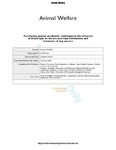Purchasing popular purebreds: investigating the influence of breed-type on the pre-purchase motivations and behaviour of dog owners
| dc.contributor.author | Packer, RMA | en |
| dc.contributor.author | Murphy, D | en |
| dc.contributor.author | Farnworth, MJ | en |
| dc.date.accessioned | 2017-08-11T15:47:46Z | |
| dc.date.accessioned | 2017-08-11T15:52:32Z | |
| dc.date.available | 2017-08-11T15:47:46Z | |
| dc.date.available | 2017-08-11T15:52:32Z | |
| dc.date.issued | 2017-05-01 | en |
| dc.identifier.issn | 0962-7286 | en |
| dc.identifier.uri | http://hdl.handle.net/10026.1/9801 | |
| dc.description.abstract |
How and why dog owners select a specific breed may impact upon the health of the dog they acquire, and upon the wider health of the breed they select. Brachycephalic breeds are rapidly increasing in popularity despite increasing evidence linking brachycephalism with chronic and severe health conditions. This study used a questionnaire to explore pre-, during and post-purchase behaviours and attitudes of dog-owners who own popular brachycephalic dog breeds (n = breeds) compared to popular non-brachycephalic dog breeds (n = breeds). The survey received 1,427 valid responses. Brachycephalic breed owners were younger, more likely to live with children, and to be buying their chosen breed for the first time. The factor that most highly influenced brachycephalic owners decisions to buy their breed was appearance, followed by breed size suited to lifestyle, good dog breed for children and good companion breed. Perceived health of the breed was less influential in decision-making for brachycephalic owners compared to non-brachycephalic owners. The way in which owners acquired their dog differed by breed type, with brachycephalic owners more likely to use puppy-selling websites to find their dog, less likely to see either parent of their puppy, and less likely to ask to see any health records. Despite many brachycephalic breed health issues being directly related to conformation, appearance remains the most significant determinant in why people desire these breeds. More targeted educational interventions are needed to change buyer attitudes and, if ineffective, other more direct mechanisms (eg legislation) may be required to protect canine welfare. | en |
| dc.format.extent | 191 - 201 (11) | en |
| dc.language.iso | en | en |
| dc.publisher | Universities Federation for Animal Welfare | en |
| dc.relation.replaces | http://hdl.handle.net/10026.1/9799 | |
| dc.relation.replaces | 10026.1/9799 | |
| dc.title | Purchasing popular purebreds: investigating the influence of breed-type on the pre-purchase motivations and behaviour of dog owners | en |
| dc.type | Journal Article | |
| plymouth.issue | 2 | en |
| plymouth.volume | 26 | en |
| plymouth.publication-status | Published | en |
| plymouth.journal | Animal Welfare | en |
| dc.identifier.doi | 10.7120/09627286.26.2.191 | en |
| plymouth.organisational-group | /Plymouth | |
| dcterms.dateAccepted | 2017-04-01 | en |
| dc.rights.embargoperiod | Not known | en |
| rioxxterms.versionofrecord | 10.7120/09627286.26.2.191 | en |
| rioxxterms.licenseref.uri | http://www.rioxx.net/licenses/all-rights-reserved | en |
| rioxxterms.licenseref.startdate | 2017-05-01 | en |
| rioxxterms.type | Journal Article/Review | en |


